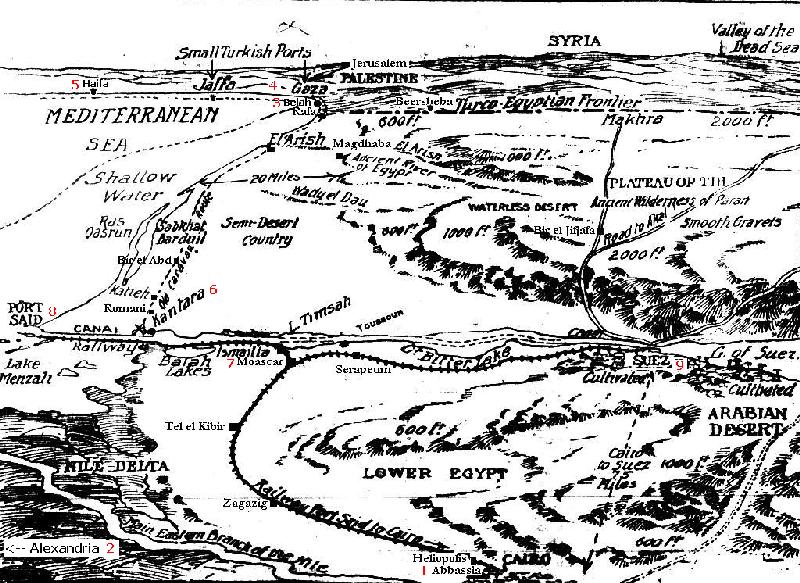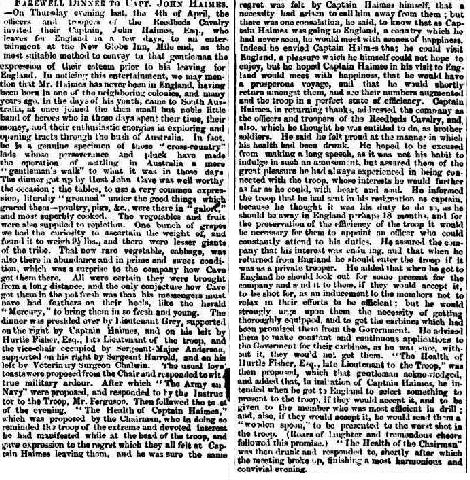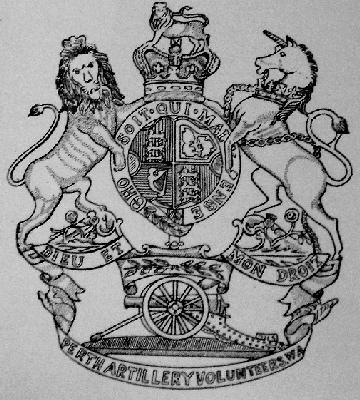Topic: AIF - Lighthorse
Light Horse
B103, Casualty Form - Active Service
Index to Common Terms

Index to Common B103 Terms
When examining the Light Horseman's Service File, one of the most common forms in the Service File is the B103, the Casualty Form - Active Service. Every movement of the soldier is recorded. The reasons for this are fourfold.
1. The location of the soldier at any one time was essential to establish where his rations were to be drawn.
2. The form established the entitlements to drawing pay at a particular level. A soldier in the field was allowed to draw pay but when in hospital was not allowed to draw their pay as it was considered that everything to assist the soldier's recovery was provided.
3. By tracking the movements of the soldier, it allowed early detection of desertion if that were to occur.
4. At the end of the war, the chronology of this form was used as the basis for post war entitlements such as medals, pensions, repatriation assistance, access to hospitals and any other service available for an ex-serviceman for the rest of his life.
The B103 may be as simple as one sheet or multiple sheets. It depended upon the individual serviceman.
[Click on map for larger version.]
[Adapted From: Melbourne Age, 6 February 1915, p. 11.]
Common B103 Terms
Locations
The numbers next to the towns refer to the numbers in the map above.
Abbassia - 1 - A major city precinct in Cairo. Many of the major Allied hospitals were located in this district.
Alexandria - 2 - The chief northern port located in the Nile Delta.
Belah - 3 - Full name is Deir el Belah, a small village in Palestine about half way between Gaza and the Egyptian - Palestine border. It served as the camping area of the Desert Mounted Corps in 1917.
Gaza - 4 - The major southern coastal city of Plaestine where three major battles took place in 1917. It became a hub for Allied supply receipt and distribution.
Haifa - 5 - A coastal city in northern Palestine with a substantial Jewish population [1918]
Kantara - 6 - The largest Allied supply depot in Egypt during the war.
Moascar - 7 - An Egyptian town near the Suez Canal where the Allied training depots were located.
Port Said - 8 - Port at the northern end of the Suez Canal. It contained many Allied Rest Camps
Suez - 9 - Port at the southern end of the Suez Canal. The main embarkation destination for Australian and New Zealand troops
Australian References
Middle East References1st MD - 1st Military District. This District incorporated all Queensland, part of Northern New South Wales and Darwin from the Northern Territory.
2nd MD - 2nd Military District. This District incorporated most of New South Wales except for the Northern District in the 1st MD, a few towns on the Murray River which are included in the 3rd MD and the Broken Hill region which is included in the 4th MD.
3rd MD - 3rd Military District. This District included all Victoria and some towns along the Murray River that are in New South Wales.
4th MD - 4th Military District. This District included all South Australia and the Broken Hill region in New South Wales.
5th MD - 5th Military District. This District included all Western Australia.
6th MD - 5th Military District. This District included all Tasmania.
Langwarren - Former Victorian military depot near Melbourne converted into a VD Hospital and detention barracks during the Great War.
Torrens Island - South Australian island north of Port Adelaide used in the Great War to hold alien internees and a detention barracks with VD cases.
2nd Aus Stat Hosp - 2nd Australian Stationary Hospital
4 Tng Reg (e.g.) - 4th Light Horse Brigade Training Regiment
4th F Amb (e.g.) - 4th Light Horse Field Ambulance
9 MVS (e.g.) - 9th Mobile Vet Section
11 LH Regt (e.g.) - 11th Light Horse Regiment
14 AGH - 14th Australian General Hospital
21 Gen Hosp - 21st General Hospital (British)
31 Gen Hosp - 31st General Hospital (British)
24 Stat Hosp - 24th Stationary Hospital (British)
36 Stat Hosp - 36th Stationary Hospital (British)
44 Stat Hosp - 44th Stationary Hospital (British)
45 Stat Hosp - 45th Stationary Hospital (British)
47 Stat Hosp - 47th Stationary Hospital (British)
33 CC Stn - 33rd Casualty Clearing Station (British)
66 CC Stn - 66th Casualty Clearing Station (British)
76 CC Stn - 76th Casualty Clearing Station (British)
A & NZ DC & TC - Australian and New Zealand Details Camp and Training Centre, located at Moascar.
Bde HQ - Brigade Headquarters
Bonlac - An isolation hospital for contagious diseases
Con Dept - Convalescent Depot
EEF - Egypt Expeditionary Force
FP Compound - Field Punishment Compound
Isol Compound - Isolation Compound
PSRC - Port Said Rest Camp
R Camp - Rest Camp
Rfts Camp - Reinforcements Camp
Abbreviations
12th/3rd (e.g.) - A member of the 12th Reinforcements for the 3rd Battalion.
21 2/12 (e.g.) - 21 years and 2 months of age.
A/Cpl - Acting Corporal.
AAH - Australian Auxiliary Hospital.
AAMC - Australian Army Medical Corps.
AANS - Australian Army Nursing Service.
AASC or ASC - (Australian) Army Service Corps.
AB/Dvr - able bodied driver.
Act. - acting (in a temporary capacity).
ADBD - Australian Divisional Base Depot.
ADH - Australian Dermatological Hospital.
Adm./adm - admitted (usually to hospital).
ADS - advanced dressing station.
Advd. - advised.
AE & MM & BC - Australian Electrical & Mechanical Mining & Boring Company.
AFA - Australian Field Artillery.
AFC - Australian Flying Corps.
AGBD - Australian General Base Depot.
AGH - Australian General Hospital.
AIBD - Australian Infantry Base Depot.
AIF - Australian Imperial Force.
ALR or AL Rwy - Australian Light Railway.
AM - aircraft mechanic.
AMGBD - Australian Machine Gun Base Depot.
AMTS - Australian Mechanical Transport Service.
AN & MEF - Australian Naval & Military Expeditionary Force.
ANZAC - Australian (and) New Zealand Army Corps.
ANZAC Cyc Coy - ANZAC Cyclist Company/Battalion Bn.
ANZAC Mtd Reg - ANZAC Mounted Regiment.
AOC - Army Ordnance Corps.
Arty - Artillery.
ASC - Army Service Corps.
ASH - Australian Stationary Hospital.
Aux. - auxiliary.
AVES - Australian Veterinary Evacuating Station.
AVH - Australian Veterinary Hospital.
AWL - absent without leave.
B
Bar - second award of same bravery medal e.g. MM and Bar.
Batt - Battalion.
Bde - Brigade.
BEF - British Expeditionary Force (Belgium, France, England).
BGROC - Broad Gauge Railway Operating Company.
Bn - Battalion.
Btn - Battalion.
BW - bullet wound.
C
Can. - Canadian (usually General Hospital).
Capt. - Captain.
CB - Confined to Barracks, usually a punishment.
CC - confined to camp (as punishment).
CC - convalescent camp.
CCS - Casualty Clearing Station.
CO - Commanding Officer.
Com. Dep. - Command Depot.
Coy - Company.
Cpl - Corporal. The NCO grade above Lance Corporal.
Cps - Corps.
CQMS - Company Quartermaster Sergeant.
D
DAAG - Deputy Assistant Adjutant General
DAC - Divisional Artillery Column.
DAG - Deputy Adjutant-GeneralDCM - Distinguished Conduct Medal.
DCM - Divisional Court Martial.
decd. - deceased.
Den Cps - Dental Corps.
Dis. - discharged (e.g. from hospital or army).
DMC RO 288 - Desert Mounted Corps Routine Order Number 288, 28 April 1918.
Dn (or Div) – Division.
Do (or ") - ditto (same as entry above in record).
DOD - died of disease.
DOW - died of wounds.
DSC - Divisional Supply Column.
Dvr - Driver. Usually the person driving the horse drawn wagons. Drivers were paid 1/- per day above the private or trooper.
E
EDP - escort duty promotion (temporary).
EDP Cpl - Extra Depot Corporal. A person promoted to a NCO rank over and above the establishment of the unit. .
EEF - Egyptian Expeditionary Force (Egypt, Sinai, Palestine).
Emb. - embarked (boarded ship).
Emb. Roll - embarkation roll.
Engrs - Engineers.
ER Cpl - Extra Regimental Corporal. A person promoted to a NCO rank over and above the establishment of the Regiment. .
ex - from, or out of.
F
F Amb - Field Ambulance.
FA - Field Ambulance.
FAB - Field Artillery Brigade.
Far - farrier (shoesmith).
FCE - Field Company Engineers.
FGCM - Field General Court Martial.
FP - Field Punishment (e.g. No. 1 or No. 2). For minor offences Field Punishment was implemented to ensure the soldier remained at all time with his unit.
Frac. - fractured (bone as a result of wound).
G
GCC - German Concentration Camp, Liverpool.
Gen. Hosp. - General Hospital.
GHQ - General Head Quarters.
GSR - General Service Reinforcements.
GSW - Gun Shot Wound, most frequently to describe a shrapnel wound.
GW - gunshot wound.
H
HMAT - His Majesty's Australian Transport. One of the many ships leased to the Australian government at the outbreak of war.
HQ/Hdgrs/Hgrs - headquarters.
HS - Hospital Ship.
HT - Hired Transport (ship).
HT - see HMAT.
HTMB - Heavy Trench Mortar Battery.
I
i/c - in charge.
ICC - Imperial Camel Corps.
In The Field - generic term for the 'Front' (usually France or Belgium).
Inf - Infantry.
Infl. - influenza.
K
KIA - killed in action.
L
L - left.
L/Cpl or L/Corp - Lance Corporal, the lowest NCO grade.
L/Sgt - Lance Sergeant.
LGROC - Light Gauge Railway Operating Company.
LH - Light Horse.
LH Bde - Light Horse Brigade.
LHFA - Light Horse Field Artillery.
LHR - Light Horse Regiment.
Lieut. or Lt. - Lieutenant.
Lt-Col. - Lieutenant Colonel.
LTMB - Light Trench Mortar Battery.
M
M Vet-Sect; MVS - Mobile Veterinary Section.
M/I; m/i, M/I; M/in - Marched in. The date when a soldier joined a unit.
M/O; m/o; M/o; M/out - Marched out. The date when a soldier departed from a unit.
MC - Military Cross.
MD - Military District.
MEF - Mediterranean Expeditionary Force (Gallipoli).
MG Bn - Machine Gun Battalion.
MG Coy - Machine Gun Company.
MG Sqn - Machine Gun Squadron.
MIA - missing in action.
MIL. - Military.
MM - Military Medal.MMP - Mounted Military Police
MO - Medical Officer.
MSM - Meritorious Service Medal.
MT/Dvr - motor transport driver.
MTMB - Medium Trench Mortar Battery.
MU - Medically Unfit. This was one of the most common reasons for a soldier's early discharge from the AIF.
N
NCO - Non Commissioned Officer.
ND - No diagnosis.
NME - non-military employment (leave after Armistice which provided industry placement and training).
NOK - next of kin.
Nom Roll - Nominal Roll.NONR - Not on Nominal Roll. This occurred when the individual was not recorded on the Embarkation Roll and returned to Australia after October 1919 subsequent to the closing of the Nominal Roll.It also was recorded when a person was engaged in an occupation not deemed to be recorded on the Nominal Roll yet performed service in a theatre of war which required recognition.
NYD - not yet determined or diagnosed.
O
O/seas, o/s, Oseas - overseas.
OC - Officer Commanding.
P
Pnrs - Pioneers (Pioneer Battalion).
PO - Petty Officer (Naval Bridging Train only).
Proc. - proceeded.
Pte - Private. The lowest rank in the force.
PUO - pyrexia of unknown origin (usually 'trench fever').
R
R - right.
RAA - Royal Australian Artillery.
RAE - Royal Australian Engineers.
RANBT - Royal Australian Naval Bridging Team.
RAP - regimental aid post.
Re or re - about, regarding, in relation to.
Reg. - Regiment.
Regt - Regiment.
REIN. - Reinforcements.
Reinf. - Reinforcements.
retg. - returning (e.g. to Australia).
RFA - Royal Field Artillery.
RMO - Regimental Medical Officer.
RMT Unit - Remount Unit.
RSD - Railhead Supply Detachment.
RSM - Regimental Sergeant Major.
S
S/Smith - shoeing smith (farrier).
SAN Sect - Sanitation Section.
SB - Siege Battery.
Sect. - Section.
Sgt - Sergeant. The NCO grade above Corporal. .
Sig - Signals.
Sig. Tp - Signals Troop.
SIW - self-inflicted wound.
Sqn - Squadron.
STS - Sea Transport Staff.
Sty. Hosp. - Stationary Hospital.
SW - shrapnel wound.
T
Temp. - Temporary (promotion).
Tfd. - transferred.
TOS - Taken on Strength. This was the process of adding a person to the ration strength of a unit.
Tp - Troop (Light Horse).
Tpr - Trooper. In early 1915, the AIF ordered that all members of the Australian Light Horse who were at the rank of Private were to be thenceforth called "Trooper".
Trans. - transferred.
V
V.D. - Volunteer Decoration.
Vacc. - vaccination.
VC - Victoria Cross.
VD - venereal disease.
Vet Sect - Veterinary Section.
vice – replacing; In the place of . usually a name follows.
VO Cpl - Voyage Only Corporal.
W
Whr - wheeler (a wheelwright).
WOAS – When or while on active service.
Further Reading:
Australian Light Horse Militia
Battles where Australians fought, 1899-1920
Citation: Light Horse, B103, Casualty Form - Active Service, Index to Common Terms







